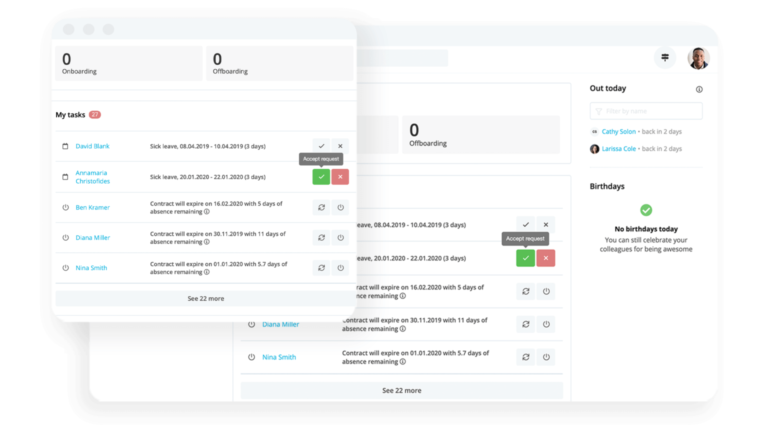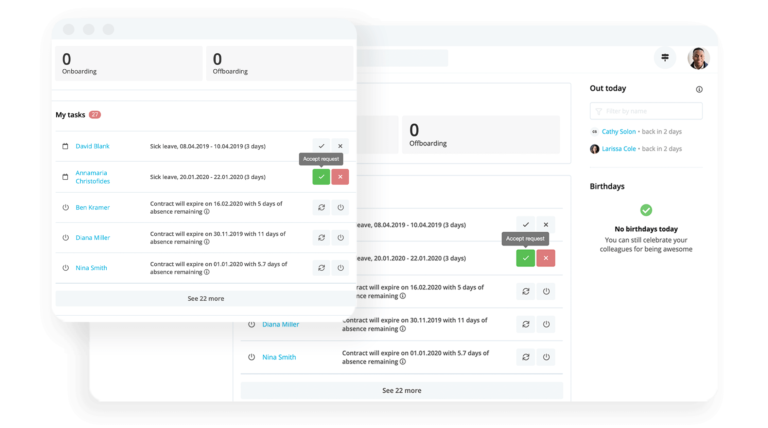Applicant Tracking System (ATS): Top FAQs Answered

Having an applicant tracking system (ATS) in place not only ensures that you find the right talent, but that you treat them to the best possible experience.
But, what is an applicant tracking system, and how does it fit into the larger picture of recruiting software?
In this article, we answer all of your biggest questions about having an ATS, why you might need one, and how you can determine the best one for your organization's needs. This way, you can offer candidates an efficient, effective, and positive experience — whether they get the job or not.
Want to cut right to the chase? Learn more about Personio’s applicant tracking system and software by clicking this link.Contents
- 1What Is An Applicant Tracking System (ATS)?
- 2What Is An Applicant Tracking System In HR?
- 3Why Do You Need An Applicant Tracking System?
- 4How Does An Applicant Tracking System Work?
- 5How Do You Know If Your ATS Is Working?
- 6What Kind Of Companies Use An ATS?
- 7How Can You Improve Your ATS?
- 8Can An ATS Improve Your Organization’s Talent?
What Is An Applicant Tracking System (ATS)?
An applicant tracking system, or ATS, is a software application that allows you to digitally handle every stage of the recruitment process. It can allow you to manage applications, parse CVs, and evaluate candidates at the click of the button. That is if you have the right one in place.
What Is An Applicant Tracking System In HR?
It matters for HR because a streamlined and effective applicant tracking system is essential for the growth of your business. Not only are you able to find the right talent, but you are able to lead them through a seamless process that helps strengthen your employer brand and your attractiveness as a place to work.
In addition to that, having a strong ATS in place allows you to spend less time working on candidate management and more time on strategic initiatives. These can be things directly related to your employer value proposition, which will then strengthen your overall talent pool and ability to attract and retain the best employees.
So, a proper ATS has a bit of a holistic effect on your entire HR function and business, more generally. It is a piece of the puzzle, but it can play a key role in the success of your organization.
Why Do You Need An Applicant Tracking System?
For all of the reasons we listed before, and more. When you have an applicant tracking system in place, you can do more of the following:
Save candidate information along with detailed notes and tags
Access colleague-provided feedback at any time (without chasing employees)
Utilize templates to update candidates at each stage of the process
Keep employee data safe and GDPR compliant
Access up-to-the-moment analyses
All of these things can help reduce your time-to-hire, your cost-per-hire, and overall hiring cost, because you can spend less time trying to handle manual processes and chasing documents, and more time relying on the system to help provide a foundation for growth.
How Does An Applicant Tracking System Work?
It depends on the kind you want to use. When it comes to cloud-based HR software, your ATS is centrally located for every employee and is as simple as logging in and clicking a few buttons. When you have the proper software in place, like Personio’s, you have access to a dashboard that, at a glance, offers all of the information you need.
This way, you can seamlessly keep an eye on candidates, which stage they are in, and what needs to happen next. It’s all available at a quick glance, and you can even turn candidates into employees at the click of a button.
How Do You Know If Your ATS Is Working?
Being able to evaluate your ATS is a key part of strategic HR, which is why Personio makes it easier to make data-driven decisions within our HR software.
In fact, Personio generates tracking links for your jobs page to determine where candidates are coming from, and which channels are performing the best. This way, you know where to invest your time and money, so that you can get the best candidates for the roles you need to fill.
At the same time, and on a more granular level, Personio can give you an overview of an applicant’s status and in which phase of the hiring process they are currently in. This means that if there is a ‘problem phase,’ you can find out quickly and ask yourself some crucial questions, such as:
Are your job advertisements incomplete or ineffective?
Which recruiting channels are underperforming for candidate quality?
Do candidates back out because the process takes too long?
Each of these questions can unlock a world of insight, but it starts with a strong foundation. That means having an ATS that can house all of this information, securely, so that you can operate on clean, meaningful data.
15,000 organisations trust Personio for this reason

Just like LUSH and Premier Inn, trust Personio's all-in-one HRIS to upgrade your people operations for now and into the future. Click below to learn more about us.
Book Your DemoWhat Kind Of Companies Use An ATS?
While smaller companies can get away with using spreadsheets, or doing everything over email, SMEs often always need an ATS to help ensure they are positioned for growth. That’s because with a high number of applicants comes the potential for a lot of things to go unnoticed. So, you need a system that centralizes all of it.
And, you need the data to know whether you are spending your time on the right things. For larger businesses, this means having the data to back up each and every decision you make. As well as the confidence to know which channels are performing the best, and how you can get your jobs in front of the best candidates.
How Can You Improve Your ATS?
The first way to currently improve your applicant tracking system is to assess your options. Is your current recruitment software allowing you to provide a seamless and successful candidate experience?
Our complimentary guide to switching to a new HR solution.
Moreover, have you digitized your ATS in the first place? Oftentimes, the first step is to introduce a solution to start the process, but you need to make sure it is the right solution for your needs.
Once you have HR software and an applicant tracking system in place, it helps to build a workflow that works for your needs. Then, you can automate that workflow with templates and defined steps.
After that, it’s about relying on the data to figure out what’s working, what’s not, and where you can improve things to make them work for your organization. Thankfully, with an ATS in place, your people function will now have the time to truly focus on these strategic initiatives.
Can An ATS Improve Your Organization’s Talent?
Of course, because it can ensure that your jobs get in front of the right people, in the appropriate ways, and that they can have a great experience from the moment they hit ‘apply.’ This means you get stronger candidates in your pipeline, a higher level of talent at your organization, and a talent management system from the start.
An applicant tracking system can be the first step. Learn more today about how Personio can help, or download one of our helpful guides or whitepapers when it comes to digitizing and optimizing any one of your core HR processes.

